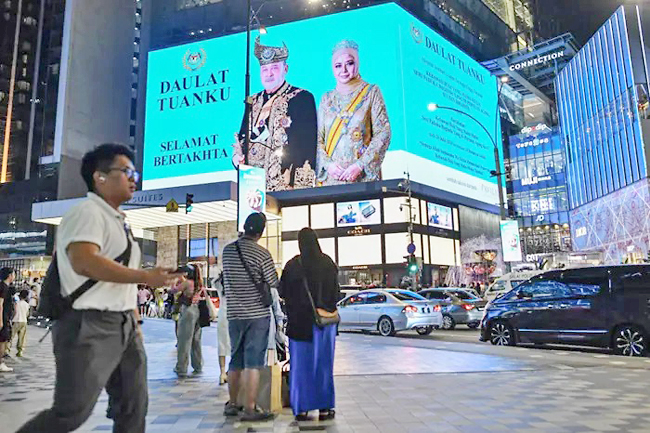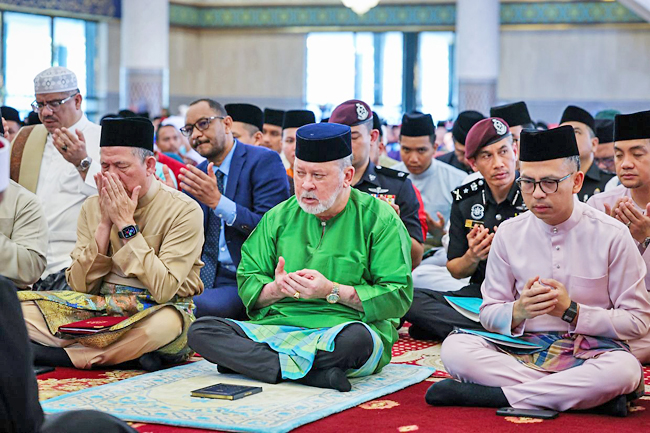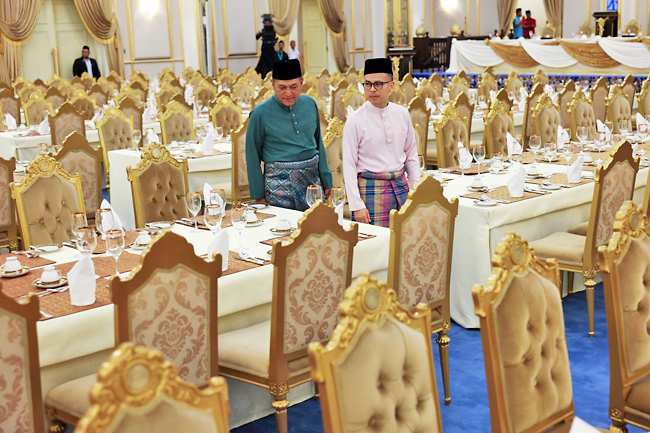ANN/THE STAR – An installation marking the coronation of His Majesty Sultan Ibrahim as the 17th King of Malaysia will take place today in a ceremony rich with royal Malay customs and traditions at Istana Negara.
Set to be held in the Balairung Seri of Istana Negara, the event will officially commence Sultan Ibrahim’s five-year tenure as the Head of State.
The National Palace, or Istana Negara, has been lavishly decorated to celebrate the occasion, underscoring its importance as a cornerstone of the constitutional monarchy system.
The grand and solemn installation ceremony is a testament to the enduring legacy of the monarchy since Malaysia’s independence.
Communications Minister Fahmi Fadzil, who chairs the Special Committee for the King’s installation Events, stated that preparations are going well and expressed his privilege in being part of this historic occasion.
“I feel humbled by this experience and never imagined I would be given such a responsibility. It is an honour to contribute to ensuring the smooth execution of all events related to the King’s Installation ceremony,” he said in an interview with The Star.
The events surrounding the King’s installation began with the recitation of Yaasiin and Doa Selamat at the National Mosque on Thursday, followed by the special Friday sermon and prayers at the same venue yesterday. Her Majesty Raja Zarith Sofiah, Queen of Malaysia, is scheduled to visit the Orang Asli Hospital in Gombak on July 23, and grace other events such as the Raja Kita exhibition at the National Museum on July 25.
The events will conclude with a tea reception at Istana Negara on July 27.
His Majesty Sultan Ibrahim had overseen all aspects of the installation ceremony, said Fahmi. The minister described Tuanku as extremely detail-oriented.
“We had an audience with His Majesty and were tasked with briefing Tuanku on the whole preparation.
“Tuanku was very astute and precise with all the details.
“His Majesty is very particular and detailed. His Majesty had asked us, ‘Do I do this? Who is sitting where? What is the order of the event? What is the sequence? How long will it take? Is this the right length of time?’,” Fahmi shared.



“So this will be very special, as it has Tuanku’s personal touch,” he added. It is estimated that over 2,000 people were involved in ensuring the smooth running of the ceremony, including Istana Negara staff and representatives from other departments and agencies such as the Royal Malaysia Police, Malaysian Armed Forces, and the Public Works Department.
Among the royal guests expected to attend the installation ceremony at Istana Negara are His Majesty Sultan Haji Hassanal Bolkiah Mu’izzaddin Waddaulah ibni Al-Marhum Sultan Haji Omar ‘Ali Saifuddien Sa’adul Khairi Waddien, Sultan and Yang Di-Pertuan of Brunei Darussalam and the King of Bahrain Sheikh Hamad bin Isa Al Khalifa. To date, a total of 16 instruments of royal invitation for the installation have been presented to the respective Sultans, state Governors, and other royal guests, noted Fahmi.
Fahmi recounted his unforgettable experience, sharing that Sultan Ibrahim invited him to join His Majesty’s entourage for an audience with His Majesty the Sultan and Yang Di-Pertuan of Brunei Darussalam.
“Upon our return, when we arrived at the Johor Royal Hangar in Senai, Tuanku decreed I was to ride in the same car, which His Majesty drove back to his palace himself.
“It was truly a privilege and a special moment for me,” said Fahmi.
The first King’s installation took place at Dewan Tunku Abdul Rahman, now known as the Malaysia Tourism Centre in Jalan Ampang, as Istana Negara had not yet been established then. The building witnessed five installation ceremonies of the Yang di-Pertuan Agong, with the last being the installation of the Sultan of Kelantan, Sultan Yahya Petra ibni Almarhum Sultan Ibrahim as the sixth Yang di-Pertuan Agong on February 28, 1976.
The installation of the 17th Yang di-Pertuan Agong today will certainly be a very special moment for Sultan Ibrahim, as His Majesty will be going through a similar process that his father, the late Sultan Iskandar Sultan Ismail, went through when the late Ruler ascended the federal throne as the eighth Yang di-Pertuan Agong 40 years ago.
The Grand Chamberlain of Istana Negara, Datuk Azuan Effendy Zairakithnaini, told Bernama that the ceremony will evoke memories of Sultan Iskandar’s installation, as Sultan Ibrahim will sit on the same throne used by His Majesty’s late father.
“The throne was previously used by Sultan Iskandar, so it certainly holds a special meaning for Sultan Ibrahim,” he said.
Azuan Effendy also said that even though the ceremonial aspects of the Yang di-Pertuan Agong’s installation ceremony have remained intact since 1957, each event had a unique charm, thanks to the personal touches of the reigning Yang di-Pertuan Agong and Raja Permaisuri Agong.
For the upcoming installation ceremony, the royal couple’s favourite colour, Tiffany blue (similar to cyan but slightly lighter), has been incorporated into certain elements along with the royal yellow and Johor’s royal blue colours.
His Majesty is also directly involved in several matters, including personally selecting the design for the souvenirs and medals to be given to guests.
“Sultan Ibrahim has prioritised the hibiscus pattern, which symbolises His Majesty as the Head of State of Malaysia, even though the Johor royal emblem features motifs of pepper (and gambir) plants,” said Azuan Effendy.
The hibiscus is Malaysia’s national flower, as declared by the first prime minister, Tunku Abdul Rahman Putra Al-Haj, on July 28, 1960. – Rahimy







